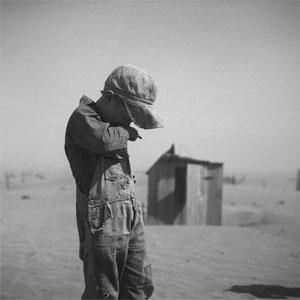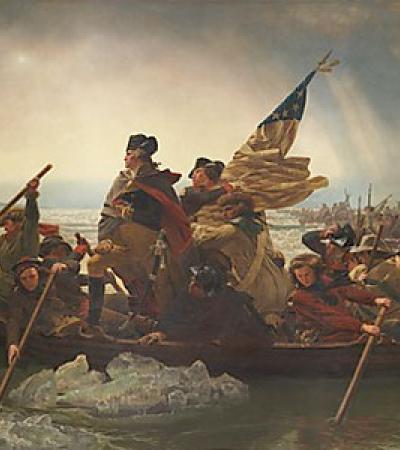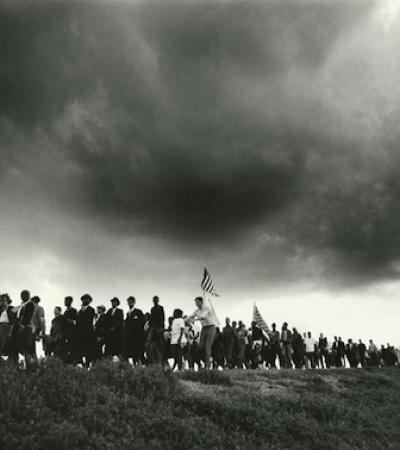This month, EDSITEment provides a teacher’s companion to the PBS documentary The Dust Bowl, looks at the inner chapters in Steinbeck’s Grapes of Wrath, enhances your understanding of Vonnegut’s classic short story “Harrison Bergeron,” discusses the Electoral College, reviews Abraham Lincoln’s presidency, and offers a Spanish language lesson plan for beginners on colors.
The Dust Bowl

Just before the turn of the twentieth century, the Southern Plains were being touted as “the last frontier for agriculture” in America. By the 1910s, rising wheat prices, a war in Europe, and several years of unusually high rainfall created a land boom known as the “Great Plow-Up.” Millions of acres of thick native grassland were converted into wheat fields virtually overnight. People swept into the area like locusts, buying up land, building boom towns, hoping to hit it rich and achieve the American dream.
By 1931, the Southern Plains were on their way to a near decade-long natural disaster of Biblical proportions. The constant plowing of the land upset the delicate balance and exposed huge swaths of once native grassland to dry weather and high winds. At its peak, 100 million acres in Oklahoma, Texas, Kansas, Colorado, and New Mexico were hit with dust storms that rose 10,000 feet into the air, and 2.5 million desperate Americans left their homes in a massive exodus to start new lives.Watch Ken Burns two-part series on PBS, The Dust Bowl, and use EDSITEment’s companion teacher guide to learn more about this chapter in American history.
The Grapes of Wrath: The Inner Chapters
John Steinbeck recognized that one of the most criticized elements of The Grapes of Wrath was his alternating use of inner (also known as intercalary) chapters that interrupt the narrative of the Joads. The inner chapters were designed by the author. Why did he include them? The Grapes of Wrath opens with a brief ecological look at the Plains drought in the first inner chapter. What purpose does this chapter’s “inner” narrative serve? In this lesson, students will first determine the function of Steinbeck’s opening chapter which acts as the first “inner chapter.” They will then explore the relationship between inner chapters and the Joad narrative chapters throughout the novel.
Kurt Vonnegut’s “Harrison Bergeron”
Kurt Vonnegut’s story paints a picture of a society that few of us would gladly embrace, even those of us who care deeply about social equality. It thus invites us to think about the society presented; its rebellious genius, Harrison Bergeron; as well as Vonnegut’s purpose. This Launchpad provides background materials and discussion questions to enhance your reading and understanding of the classic short story.
The Electoral College
Every four years, on the first Monday after the second Wednesday in December, the members of the U. S. Electoral College meet to elect “some fit person” as the President of the United States. Almost everyone in America, thanks to the presidential election mess of 2000, knows that the Constitution provides that the president will be selected by an Electoral College, not by direct popular vote. Yet the Electoral College is one of the least understood aspects of the original Constitution.
Teaching Abraham Lincoln: The End of Slavery
The years in which Lincoln served as president, 1861–1865, were the most momentous in the nation’s history. As commander-in-chief, he rallied Northern armies to victory over the South. In his speeches prior to the Civil War, Lincoln returned again and again to the principles of the Declaration of Independence to show the American people (and the world) that slavery was a profound denial of the natural rights of black people. In this Spotlight, EDSITEment showcases a range of lessons, student interactives, and multimedia-rich Web sites that will help teachers, students, parents, and caregivers understand the world Lincoln lived in and the impact he had upon it. It also includes NEH-sponsored programs, exhibits, and professional development opportunities for teachers.
De Colores: A Language Lesson Plan for Novices
It is important for Spanish-language students to develop simple vocabulary and pronunciation, and this lesson plan can be an excellent tool for this. The vocabulary—the colors—is appealing to young learners because colors are easy for them to comprehend and observe while connecting the newly acquired vocabulary to familiar objects. The activities in this lesson plan will help students learn ten colors in Spanish and also provide them with practice to use them in context.



